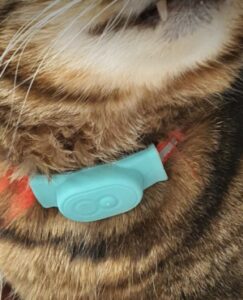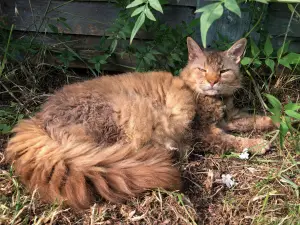When a cat breaks out of its routine and doesn’t come home, a silent fear grips genuine pet owners. I’ve experienced it too. While these feline disappearances may seem odd at first glance, there are various reasons for why and how cats go missing. We learn with each feline in our lives and can implement changes to hopefully reduce their disappearances.
From my experience of having five cats go missing in different locations and reasons, it takes a significant emotional toll when there’s no closure or you blame yourself. Over time, you get used to the idea of their disappearance or untimely death, but it still leaves you with so many unanswered questions. Before Dixie and PJ died, I purposefully chose a home in the countryside and away from constant traffic to keep them safe. But it backfired and I blame myself.
My feline family:
- Muffin aged 3 – Road traffic accident by a speeding van on a no-through road
- Joey aged 1 – An indoor cat who escaped the home. Reunited eight weeks later
- Sam aged 1 – He moved out. He wanted the outdoor life more. Now aged 17 and still missing
- Dixie aged 2 – Road traffic accident when she bolted from our shared access drive onto a quiet no-through, short lane
- PJ aged 3 – He didn’t come home during the evening. Early next morning I found him hidden in tall grasses and a hedgerow where I’d searched the night before but didn’t see him. Death from rat poison or bleach in our toilet
Can you see the similarities in ages?
What causes cats to go missing?

1: Exploration instincts – All cats have different personalities. Cats are curious creatures and may often explore further afield, especially at night when hunting mode kicks in.
2: Sex – Preventing unwanted litters is one reason why it’s important to have your cat neutered or spayed. When in need of a mate to fulfil sexual urges, either sex will roam further afield.
3: Predatory threats – All animals face threats from other animals. There is conflicting advice about foxes; sometimes, a fox carrying its cub is mistaken for a cat. However, all larger animals in the UK pose a significant threat, including sighthounds and sometimes quite dangerously. A cat will hide following a dog attack, and return home when they feel it is safe and if able to.
Another threat is a male cat in heat, which will react aggressively towards cats of either sex. Timid cats may become terrified and run and hide. Recently, an intact male appeared in our cul-de-sac and cornered three cats (male & female) beneath a car and refused to allow them an escape.
4: The indoor cat – Felines kept indoors will be unfamiliar with their immediate surroundings and if they escape will become disorientated, and if frightened may run off. When Joey escaped the home, he suddenly bolted from a loud noise. He couldn’t find his way home but was seen nearby in the local woods and fed in a garden at the same time each night. We were reunited eight weeks later.
5: Disorientation – Any cat can become disoriented outdoors, particularly in unfamiliar surroundings, making it challenging for them to return home – an example is a house move.
Some cats have been known to leave their new home and return to their original home.
Allowing your cat time to adapt to its indoor environment first is necessary followed by a gradual introduction to the outdoors.
6: Moving out – Some cats dislike change and become unhappy. Examples are young children, a dog, another cat, a visiting cat, or not enough outdoor time. So they find another home. However, if the change is temporary, a cat may return.
7: Travelling in a vehicle – Sometimes, cats jump unseen into vehicles and travel a great distance. If the driver is oblivious, the feline passenger may escape the vehicle into a new unknown territory. However, if found, there is the opportunity of being reunited if microchip contact details are up-to-date.
8: Theft – Pedigree cats might be resold for profit. An un-neutered cat will be used on a kitten farm and each litter sold for profit online. Conditions in a kitten farm are dire, disease-ridden and filthy. Some will be used for bloodsports.
Under British law, cats are regarded as property. The theft of a cat is treated as an offence under the Theft Act 1968.
9: Giving birth – Pregnant cats may go in search of a quiet location outdoors to give birth. This also presents a danger from predators, theft and hypothermia.
10: Old age – Cats are known to go to a quiet place to pass away. The disappearance of older cats may be because it is their time to pass. Dementia can cause forgetfulness and confusion leading to a feline getting lost. Even sudden blindness – for example, hypertension.
11: Extreme temperatures – Like dogs, cats can suffer heatstroke. We all know cats are prone to laying in full sun, but can become dehydrated and collapse. Cold weather is another threat with death from hypothermia.
12: Poisons – Several indoor and outdoor plants, pesticides, and anti-freeze are examples of poisons which a cat may ingest outdoors. Indoor lilies are toxic and if adding toilet bleach, close the lid. Carpet flea powders and sprays containing permethrin are highly toxic to cats. These poisons can cause many symptoms including collapse and death.
ICatCare Video: Cat suffering from Permethrin poisoning – this feline survived with veterinary intervention
My article, Common Dangers for Cats Outdoors, highlights several hazards felines face outside and in the home.
13: Shut in outbuildings – Cats are notorious for being curious and one well-known occurrence is being shut in a shed, greenhouse or garage. I installed a cat flap in my shed and always left a full water bowl in case I locked in a cat. Cats are good at hiding and being quiet.
My article TabCat, is about a cat tracker that isn’t dependent on GPS. The simple device can find your cat trapped in outbuildings up to one inch of their location. It operates with a directional handset.
14: Unsecured spaces – Inadequately secure gardens or open windows provide escape routes for cats. Cats are known for getting through the smallest gap. Joey escaped when I didn’t close the door properly.
15: Human factors – Accidental trapping and relocation by well-meaning individuals is a common factor – for example, your cat is taken to a rescue centre. Unfortunately, other well-meaning individuals see a stray and give it a home without considering it might be chipped and lost.
PJ hung around our garden, so after displaying posters to capture the attention of potential owners without success, PJ was accepted into my feline family. He did not have a microchip.
Spiteful neighbours have been known to capture a cat and dump it further afield.
16: Transport hazards – Road traffic accidents are common, especially at night so keeping your cat indoors is necessary.
My article gives statistics on road traffic accidents and common factors with location and age.
17: Veterinary intervention – Cats will hide when injured. If lucky to be found they may be taken to a vet. However, if the injuries are too severe, euthanasia may be an option to prevent suffering. If a cat has an unregistered microchip, then an owner may never know the outcome. Vets will post on social media but do not advertise with posters so if the owner doesn’t have an account, the outcome may never be known.
18: The hidden reason why a feline may go missing is domestic abuse and violence.
How to stop your cat from going missing?

1: Consider securing unsecured spaces with window and door screens to prevent an indoor cat, an old cat or a pregnant Mum from escaping.
- Heavy-duty pet door screen from Amazon
- Self-adhesive window pet screen from Amazon
- White mesh with fixings pet window screen from Amazon
- Etsy sell a variety of pet window and door screens, including videos
You may be considering temporary pet fostering for cat charities helping domestic abuse victims leave the relationship, in which case, screens are important because the foster cat will need to stay indoors.
2: Give your cat the enrichment it needs by cat-proofing the garden or installing a catio attached to the house. A catio gives any cat fresh air and enrichment in safety.
- Felisafe for self-installation or installation in the local area
- Protecta Pet for DIY installation or installation with a nationwide service
Types of cat safety installation for the outdoors:
- Complete garden enclosure (with ‘ceiling’)
- Cat runs
- Fence toppers
- Catios
- Balcony protection
Service from Felisafe was friendly and family-orientated and I preferred them compared to a lack of response from ProtectaPet but the choice is yours.
3: Transport is a killer for cats and you don’t need to live on a busy road. Road traffic accidents can happen even in a cul-de-sac. Cat-proofing the garden can prevent this but doesn’t need to be of great expense. YouTube has a wealth of information on installing a DIY cat-safe garden.
4: When you move home, keep your feline indoors for the first eight weeks and then introduce your cat outside but wearing a harness. When you feel your feline is happy and secure in its surroundings, then remove the harness. However, remember a free-roaming cat can still go missing. I believe additional security with a harness is necessary to encourage a cat to adapt and grow in confidence with new sounds, scents and neighbourhood cats.
- Cat harnesses and leads on Amazon
- Cat harness and leads at Zooplus
5: I’ve owned cats that are daring and others that prefer garden and indoor time. If your cat is known for exploring for a few hours, accidents can befall them. A tracker might be an option for you.
- TabCat does not rely on GPS – Visit TabCat shop on Amazon
- Tractive does rely on GPS – Visit Tractive shop on Amazon
6: For a microchip to help reunification, you must register the chip. When you move, or change a mobile number, remember to update the microchip by doing so on your account or calling the company. Also, attach an ID tag to the collar so the finder can contact you directly but don’t forget to keep the information up-to-date.
Microchip companies charge to update details but transferring the chip to PetDatabase gives you free options. My pets are registered with them.
Watch the #Short: Tabitha and Molly tell you a story
Never register with the UK Pet Chip Registry because it is a scam site. Read more from Bilton Vets.
7: Do not assume your senior or geriatric feline is in perfect health. Older cats tend to stay in the garden but others won’t. I give a home to senior cats and each has developed health conditions which include daily medication, and another had dementia. And a senior cat is less likely to defend itself. Any feline loss is awful, but to live the final weeks as a stray, unable to catch food and clamber up a tree for safety shouldn’t happen in its twilight years. Securing your garden is vital.
8: Getting your cat neutered or spayed will stop either sex from wandering. Male cats tend to fight and this will stop injury and cost implications if a veterinary visit is required. Rescues advertise discounts so follow local shelters on Facebook.
9: Create a nesting box in your home so your pregnant cat can give birth in a warm, quiet and safe environment.
10: I shall be starting short-term cat fostering with Cats Protection later this year as I’ll be moving into a home of my own again during the summer of 2024. I’ll be ordering pet screens and will make a video or Short showing you on my YouTube channel so please subscribe. I fled domestic abuse in March 2023 and cat fostering is part of LifeLines – fosterers look after cats for a five-month period which gives a victim the chance to go into a refuge. Both these options can save the life of the owner and pet.
Further reading about cat fostering with LifeLines
Watch and listen: Domestic abuse awareness from my own experiences
The heartache of loss and the impact on owners
Emotional turmoil – A true and loving pet owner can develop profound sadness, anxiety, stress, depression and guilt over the disappearance of their beloved pets.
Disrupted routine – Cats play integral roles in an owner’s daily life, and their absence creates a horrid void.
Financial burden – The search for missing cats can incur significant expenses, including the printing of posters, flyers, and professional services, adding to the emotional strain.
Time – Working full-time feels a burden when you want to be searching for your pet. This can cause anxiety because you feel time is lost, coupled with the loss of concentration at work.
Watch the Video: Long -term missing UK dogs (2011 – 2018) and methods locating your lost dog
You might be interested in my articles listed in Stolen, Lost, Found & Help
What do you do if your cat is missing?
Immediate action is necessary because time is of the essence in locating missing cats. Owners should commence search efforts promptly, scouring nearby areas and enlisting the help of neighbours. Traditional methods, such as a photocopied handmade poster can be put through letterboxes on your street. Joey visited a home two streets away at 10 pm nightly, so focusing on streets in the surrounding area can contribute to finding your feline.
Utilising technology such as popular social media platforms is important. Shorts or Reels will gain the highest views because they appear more frequently on a newsfeed than full-length videos.
I recommend platforms TikTok, YouTube and Facebook adding footage ranging from 60 seconds to two minutes depending on the platform you use. Footage can be shot using your mobile and uploaded directly using the platform app.
It is worth noting that YouTube and TikTok call the footage #Shorts and Facebook call it Reels. My article The Role of Social Media gives you further insight and knowledge into other features you can use to help find a missing pet.
View the #Shorts on Poppy’s Pets YouTube channel
View the Reels/#Shorts on my Domestic Abuse Awareness channel on TikTok
Of course, online forums can serve as valuable tools for spreading awareness but it depends on how many people are registered and to be honest, using a social media platform has a higher ratio of users than online forums. Adding details of your missing pet to local forums and the app NextDoor should be used, but concentrate on social media and traditional methods too.
Professional assistance by engaging in free services can help. Optional paid services are available too but can be costly.
Services available:
1: Animal Search UK has a search team that can be deployed within 24 hours with a starting cost of £1,256.40 but excludes a digital and printed campaign. Depending on your pet insurance, you may be able to claim for the cost.
Read more about Animal Search UK and its Missing Pet Search Team.
2: DroneSAR for Lost Dogs is recognised as a legitimate company offering its services – and it is free. Although it mainly deals with missing dogs, ask if they can help find your cat in your immediate area. Finding a cat using a drone may be more difficult because a cat will hide during the day so night might be beneficial. The business is operated by volunteers and includes 700 drone pilots, sniffer dogs, traps operators and ground searchers. DroneSar is featured on the Dog Lost website, a lost and found service recognised by the police, dog warden and highway agencies.
Visit DroneSAR
3: Check your pet insurance. Many policies now offer the opportunity to claim up to a maximum amount for theft or straying. Fluffy Pet insurance covers up to £1,500 – £1,800. Read the small print on your insurance as the claim may only be for the purchase price of your pet. Sainsbury’s and Fluffy pet insurance also help towards the cost of advertising and rewards.
However, pet insurance companies are notorious for finding a reason why they cannot pay out so do your homework.
Visit Sainbury’s pet insurance
Visit Fluffy Pet Insurance
4: Contact the microchip company that the chip is assigned to and change to ‘lost’ or ‘stolen’. If your missing pet becomes a long-time missing pet, always update your contact details. Pets have been reunited years later.
One important point – microchip companies have a variety of charges – I use PetDatabase because it is free and DEFRA-approved.
Charges by other companies include:
A: To register the microchip after implantation of the chip.
B: To update contact details
C: To initiate a lost and found service
D: Monthly charges.
People assume I earn commission from recommending PetDatabase but I do not. I believe in the best for our pets and doing what we can to save money too. My website category Cash, Freebies and Product Testing is about tips I discover.
Transferring from your current microchip company to PetDatabse is easy, regardless of whether your pet is missing or not.
Visit PetDatabase
5: Inform local vets and rescue centres – I doubt either has a digital match system and still relies on old-fashioned notebooks. But still, notify as many as you can and further afield to where you live.
6: My cats wear ID tags and an extra tag with the veterinary practice telephone number and any medical issues.
Visit Country Engraving is a company I’ve used for years
6: Contact any tradesman who worked in your area at the time your cat went missing. Cats are curious and may jump into a vehicle unnoticed. Anyone who leaves a vehicle door open for a short period may pique the curiosity of a feline. The problem here is that a cat can jump out unseen, or be dumped in another location by an uncaring driver. Join social media missing pet-related groups to cover surrounding villages or towns, business groups, and continue to use traditional methods. These points are vital further afield.
Old-fashioned ways to find a cat

1: In the first instance, search your home and garden. Dixie disappeared and I found her in a corner cupboard I’d been tidying.
2: Traditional poster methods are necessary to capture an audience without social media or any modern device. Posters can be printed at your local library or printers. Joey was reunited with traditional methods – I attached a poster to my bin and home window and this was seen by the finder. It transpired that Joey was living in the local woods only two minutes from my home for eight weeks.
Yes, kids will rip posters down so invest in extra advertising in your local post office, newsagent, veterinary window, bus stops and any other outlet with a high footfall.
Display new posters where the original was ripped down.
3: Adding your private mobile number to a poster can encourage scammers and game-players to contact you with distressing news or request money in exchange for your pet. Consider creating a profile on a pet-related website and using the company’s telephone number. Behind the scenes, your mobile number will be safe and unseen by the public.
However, if you do not have any social media access, then be cautious of any scam calls you may receive.
4: Creating a professional poster can be designed by your local printer, or a business on Facebook, or download the poster from your pet’s online profile. Any plans to have a bulk professionally printed must be set up in a colour co-ordination of CMYK only. If photocopying, CMYK is not necessary.
Recommended online printers: Route 1 Print but ask them to check the artwork you supplied before approving to print.
Key Takeaways to stop your cat from going missing
1: Invest in a catio, or visit YouTube and research DIY cat-proofing and construct your own. Alternatively, purchase the equipment from ProtectaPet for a professional installation. The less costly option is Felisafe
2: Install window and door screens
3: Be mindful of opening doors leading outside – cats are fast and disappear as quickly
4: If your cat is free-roaming, be prepared for any consequences
5: Your cat is likely to be killed in a road traffic accident if you live by a road – it takes just one vehicle
6: At sunset, cats become hunters more so. Call them in at dinnertime. Eventually, I trained mine
7: Cats go missing regardless of day or night
8: Invest in either a GPS tracker or TabCat to keep track of your cat
9: If your pet goes missing, act fast. This might be posters, social media and telephone calls
10: Keep microchip details up to date. The cheapest option is PetDatabase and it’s easy to transfer chip details
The disappearance of your beloved feline is distressing with uncertainty and anguish for owners. From experience, negative circumstances can still happen but we can contribute towards keeping our cats by understanding possible reasons behind these disappearances and adopting preventive measures.
Experience of missing and reunited felines

